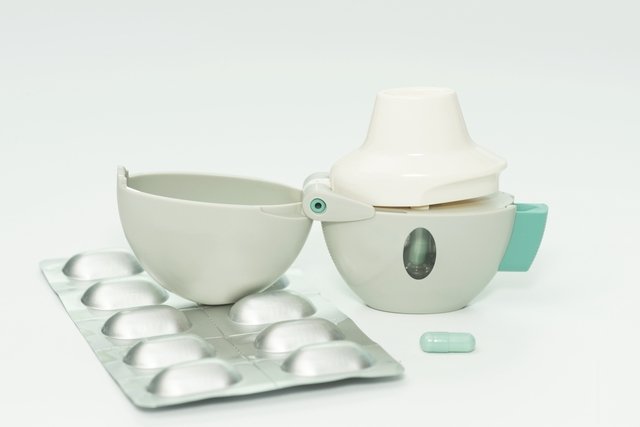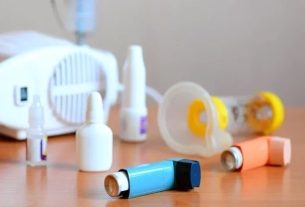Beclomethasone is a corticosteroid indicated for the treatment of respiratory tract diseases, such as bronchial asthma, bronchitis, allergic rhinitis or sinusitis, as it acts by reducing inflammation and swelling of the nasal mucosa or reducing bronchial spasms, relieving symptoms such as itchy nose , sneezing, blocked nose or difficulty breathing, for example.
This medicine can be found in pharmacies or drugstores, in the form of a nasal spray, inhaler or nebulizer vials, with the trade names Clenil or Beclosol, or as a generic “beclomethasone dipropionate”. Furthermore, it can also be found associated with other substances, such as salbutamol or formoterol fumarate, with bronchodilator action.
Beclomethasone can also be offered free of charge by the SUS, and should only be used with medical advice, for the duration of treatment and in doses recommended by the doctor on an individual basis.

What is it for
Beclomethasone is indicated for respiratory tract diseases, such as:
- Bronchial asthma;
- Bronchitis;
- Bronchial spasm;
- Allergic rhinitis;
- Perennial or seasonal rhinitis;
- Vasomotor rhinitis;
- Pharyngitis;
- Sinusitis;
- Nasal polyps, after surgery;
- Hay fever;
- Chronic obstructive pulmonary disease (COPD).
This remedy works by reducing the symptoms of rhinitis, such as a runny or stuffy nose, sneezing or itchy nose. For the treatment of asthma, bronchitis or COPD, this medicine works by reducing bronchial spasms, reducing symptoms, preventing attacks and improving lung function.
Beclomethasone, despite being indicated for asthma, should be used for the preventive treatment of asthma, and should not be used for asthma attacks, or acute asthma, as it may take a few minutes to exert its maximum effect.
How to use
The use of beclomethasone varies according to its presentation, and includes:
1. Beclometasona spray nasal
The nasal spray can be found in the form of an aqueous solution or nasal suspension, containing beclomethasone 50 mcg, and must be used nasally, applying the spray inside the nostril.
Before applying beclomethasone nasal spray, you must blow your nose gently and shake the bottle before use to mix the components of the formula.
Typically recommended doses vary with age and include:
- Adults: the normally recommended doses are 1 to 2 applications in each nostril, twice a day or as per medical advice;
- Children over 6 years old: the normally recommended dose is 1 dose, in each nostril, every 12 hours, or as advised by your pediatrician.
After using beclomethasone nasal spray, the applicator and protective cap must be washed in warm water and allowed to air dry before placing it back in the bottle.
2. Beclomethasone aerosol
Beclomethasone in aerosol form can be found in the form of a 50 mcg, 100 mcg or 250 mcg capsule to be used by oral inhalation using the inhaler provided in the package.
The beclomethasone capsule must be inserted into the inhaler, and used by placing the inhaler in the mouth with the lips closed around the inhaler, to inhale the powder contained in the capsule. It is important to tilt your head slightly down and release the air from your lungs before inhaling the contents of the inhaler.
Typically recommended doses vary with age and include:
- Children over 12 years old: The initial dose normally indicated is 100 mcg, which corresponds to 2 injections of 50 mcg, every 12 hours, or as instructed by the pediatrician.
- Adults and elderly: the normally recommended initial dose is 200 mcg, which corresponds to 4 jets of 50 mcg or 1 jet of 200 mcg, every 12 hours, or as per medical advice. In the case of beclomethasone 250 mcg, the normally recommended dose is 2 puffs (500mcg) every 12 hours.
When inhaling the inhaler containing the beclomethasone capsule, you must hold the air in your lungs for approximately 10 seconds before releasing the air, for the medicine to exert its effect.
It is important to rinse your mouth or brush your teeth immediately after inhaling the beclomethasone capsule. In addition, you must clean the inhaler with a soft brush or brush to remove residue from the capsule.
Beclomethasone aerosol 200 mcg and 250 mcg should not be used by children, but only the aerosol 50 mcg.
3. Beclomethasone inhaled sachets
The inhaled vials contain 400 mcg of beclomethasone and must be used by inhalation, through nebulization, by adults or children, using a pneumatic nebulizer. Learn how to nebulize correctly.
The doses normally recommended for nebulization in adults and children are:
- Adults: the recommended dose is 1 vial (2 mL) with each administration, 1 or 2 times a day, according to medical advice;
- Children: The recommended dose is half a vial (1mL) with each administration, 1 or 2 times a day, or as directed by your pediatrician.
If you use half the dose, that is, half a vial, you must store it in the refrigerator and use the remaining amount within 24 hours.
Possible side effects
The most common side effects that may occur during treatment with beclomethasone are headache, hoarseness, inflammation and irritation of the throat, oral candidiasis, wheezing, nausea, heartburn, stomach ulcer, stomach inflammation, loss of appetite, irritation or burning of the nasal mucosa
Beclomethasone can also cause serious allergic reactions that require immediate medical attention. Therefore, you should stop treatment and seek the nearest emergency room if you experience symptoms such as difficulty breathing, a feeling of a closed throat, swelling in the mouth, tongue or face, formation of blisters on the skin or hives. Know how to identify the symptoms of a serious allergic reaction.
Who shouldn’t use
Beclomethasone should not be used by children under 6 years of age, pregnant or breastfeeding women, or by people who are allergic to the components of the formula or other corticosteroids.
Furthermore, this medicine should not be used by people with pulmonary tuberculosis, herpes simplex or other untreated viral, bacterial, fungal or parasitic infections.

Sign up for our newsletter and stay up to date with exclusive news
that can transform your routine!
Warning: Undefined array key "title" in /home/storelat/public_html/wp-content/plugins/link-whisper-premium/templates/frontend/related-posts.php on line 12
Warning: Undefined array key "title_tag" in /home/storelat/public_html/wp-content/plugins/link-whisper-premium/templates/frontend/related-posts.php on line 13



